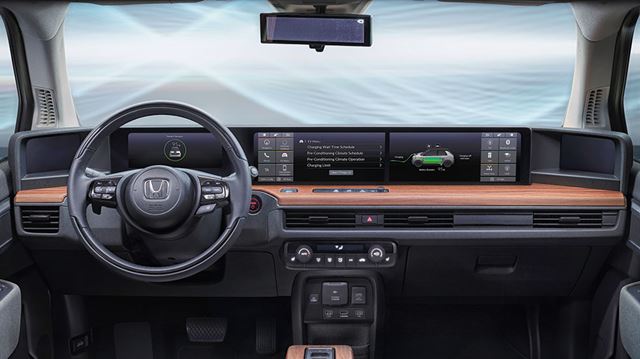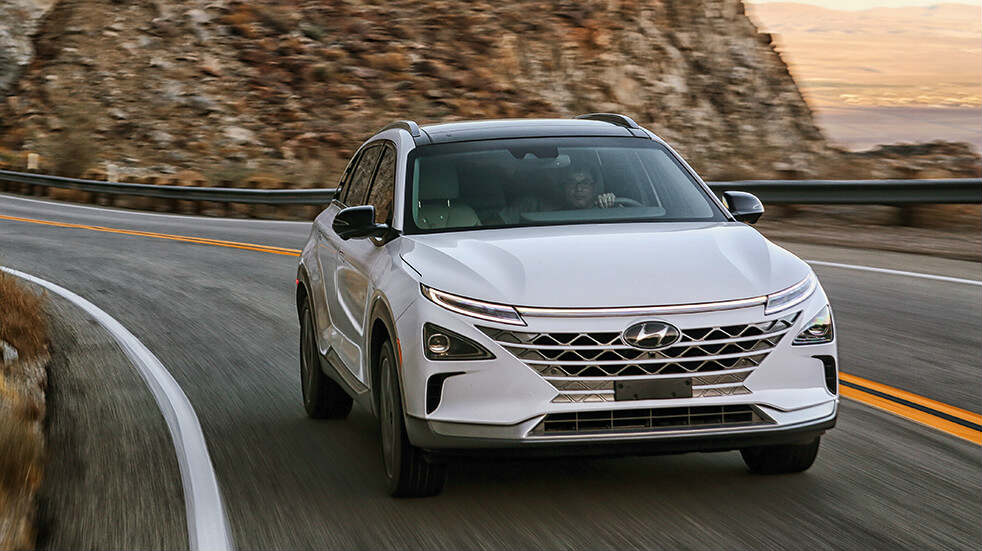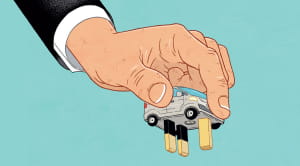
In part two of our ‘Future of motoring’ series we look at the materials and design in the latest cars
The basic design of car interiors has hardly changed in the last hundred years – but how will the issues of sustainability and technology make their mark in years to come?
As the motor car zaps headlong into its sci-fi future, we’re frequently promised a whole new on-board experience; of living rooms on wheels, and autonomously driven capsules with glassy canopies, swivelling chairs and holographic butlers. But the truth is, while the technology in our cars has changed dramatically, their interiors have evolved far more gradually. One simple reason for this is that the basic configuration still works very well.
“From an everyday use point of view, the traditional layout is a very sensible one,” says Maximillian Missoni, design director of Polestar, Volvo’s electric offshoot. “It’s not that we were forced to adopt that layout, it’s something that ergonomically makes a lot of sense.”
He’s right. In well over a hundred years of automotive history we’ve never had to radically rethink the fundamental principles of cabin design. Even the dashboard – a hangover from the wooden plank that protected carriage drivers from muck ‘dashed up’ by galloping hooves – still survives, even if these days it’s full of screens and dials. Will the shift to electric cars change the way we configure our cabins? After all, with no bulky engines to accommodate, no exhaust pipes or transmissions to route rearwards, and with drive-by-wire tech meaning fewer mechanical connections... could you put three seats across the front, or the driver in the middle?
“In terms of packaging, of course electrification gives us greater freedom,” says Max. “But you still need to store batteries – typically in the floor, but also where the transmission tunnel used to be is a good place, because it’s in the centre of the vehicle.”
Akinori Myoui, one of Honda’s interior stylists, agrees. “Batteries, in theory, could go anywhere,” he says. “But the time for spaceship-looking cars is not now – we still need to bear in mind safety features like crumple zones. Also, a familiar shape helps our emotional perception of these relatively new EVs.”
So apart from creating a little more cabin room – EV designers can now appropriate space from what was the engine bay, for example – electrification may not be a game changer after
all when it comes to interior layout.
“The real quantum leap will come with full autonomy,” says Max. “At least level four or five, when you basically lose the steering wheel – that’s when things will really get shaken up. Then you can talk about the lounge on wheels, like the Volvo 360c study, which was an exercise in exactly that type of future. But that’s not the immediate future.”
With electric cars and even autonomous vehicles on the cards, car interiors could be completely redesigned.
Read more of our specialist EV content
Find out what the fuel stations of the future will look like
Drive the best routes in Europe for electric cars
Discover Robert Llewellyn's views on the future of EVs
Material science
If electrification won’t fundamentally change the layout of our cabins, it will certainly influence their makeup, as designers look to reflect the values of sustainability in other areas, such as upholstery. Several brands including Skoda, Audi and even Ferrari now offer ‘vegan’ cabins where leather is banished. The new Polestar 2 was recently recognised by PETA for its vegan-friendly option. These alternative materials, Max explains, have benefits beyond animal welfare.
“Going leather-free also saves around 4kg, which in turn gives more range,” he says. “But it’s also a waste issue. To upholster an interior, you basically have to waste 50% of the hides, because obviously cows aren’t shaped like furniture. That’s a big waste factor that doesn’t apply to textile or vinyl options.”
With leather off the menu, carmakers are coming up with new ways to express luxury. Polestar uses a material called Weave Tech inspired by scuba and sportswear, along with reconstructed birch wood. The Range Rover Velar is available with a designer wool blend by Danish textiles company Kvadrat. Could carmakers draw further inspiration from the worlds of fashion and home furnishings?
“There’s a big difference when it comes to car interiors,” says Max. “These materials need to fulfil extremely high standards of UV, heat and cold resistance, and of abrasion and durability tests. Those are exactly the efforts that are ongoing right now. I think there will be a big development of natural wool or linen materials. And recycled plastics, which can even be harvested from the ocean, from sources including fishnets.”
Hyundai uses recycled plastics in the IONIQ, along with powdered wood. The BMW i3 uses plant-based fibres instead of petroleum-based plastics, and also eucalyptus, which requires less chemical processing than other woods. Bentley has even pioneered a type of paper-thin stone veneer, which looks like something from an expensive kitchen showroom.
Crunching the numbers
- 80: The approximate number of buttons in a mid-’90s Volvo S80. Modern Volvos typically have just 12 physical buttons and switches.
- 1986: The year the world’s first in-car touchscreen appeared. Installed in the Buick Riviera, it was called the Graphic Control Center and featured two colours.
- 25%: The portion of the BMW i3’s interior made with sustainable materials, including recycled plastics and renewables such as eucalyptus wood.
- 4KG: The typical weight reduction as a result of swapping leather upholstery for a textile equivalent in a four-seater car such as the Polestar 2.
- 91.4%: Those drivers distracted by music or audio controls. This applies to a typical three-hour drive, according to an American survey.
- 3: The average number of cowhides per leather interior. This is required for one standard size car, according to PETA.
Button down
Back in the mid-nineties, the driver of a typical executive saloon would have been faced with more buttons and switches than an airline pilot. Today though, carmakers are on a clean-up mission, filing all those controls away into touchscreen menus and digital displays. Volvo and Polestar are particularly zealous when it comes to de-buttoning.
“We’ve reduced the buttons from around 80 in older cars to about 12,” says Max. Other marques are following the same trend. Traditional instruments and controls are being rapidly replaced by smart surfaces, virtual dials, touchscreens, haptic touchpads, gesture controls and voice commands. Step into the upcoming Honda e city car and you’ll be greeted by a multiplex of screens atop a wooden tabletop dash, and a distinct dearth of buttons.
Is this really a good idea? Here’s Honda’s Akinori Myoui again. “What we didn’t want to do was just slap the displays into a normal instrument panel,” he says. “We knew that would be distracting for the driver, so we had to think about the locations carefully. And then we came back to the idea of a living room. In a living room you have a table, and you might have your TV on there, and that’s where the thinking came from.”
For some people this still goes too far. Buttons are intuitive. Touchscreens are fiddly. Nobody wants to swipe through endless menus when their eyes should be on the road. But some buttons will always be buttons because the law says so. Defrosters, indicators, hazard warning lights and other vital functions must all be operable via physical controls.

The Hyundai Nexo displays a VR view of blind spots
Virtual reality spaceships
As the internal combustion engine fizzles out, replaced by somewhat homogeneous electric motors, carmakers will have to find new ways to inject personality into their vehicles. Of course, they will still trade on their style, but customers will also increasingly look to on-board tech when deciding what vehicle to purchase.
Just look at what’s available already. Land Rover’s ClearSight tech displays images from outside the car on a screen inside, as if you’re seeing right through the bonnet – useful when navigating off-road obstacles. The Mercedes augmented reality navigation system links the real world to the virtual one by superimposing graphics into a live view of the road ahead. When you indicate to change lanes in Hyundai’s new, hydrogen-powered Nexo, it will display a wide-angle feed of your blind spot on a screen in front of you.
And with Audi’s Holoride tech, passengers wear virtual reality headsets that match the vehicle’s movements to a fantasy scenario such as flying through space – so when the car turns right, so
does your spaceship. Which might sound useless, but it will keep the kids happy...
These innovations – rather than engines and handling – could well become the new drivers of brand loyalty. “You know how it is with phones,” says Max. “Once you’re used to one kind of language, you’re really reluctant to switch to a different operating system.”
One day, when our cars eventually become self-driving pods, perhaps we won’t need any controls at all. But that really is a long way off. “For now,” observes Max, “the question is always what can we do that make’s people’s lives better? If we find a technology that enables that step, then we should definitely do it. Changing just to change something is probably not the right approach.”
Do more with Boundless exclusive member discount on LV= Electric Car Insurance
LV= tailored electric car insurance is designed with EV-specific features to keep you moving. If your battery runs out of charge in the UK, your cover ensures that you get to the nearest charging point.




